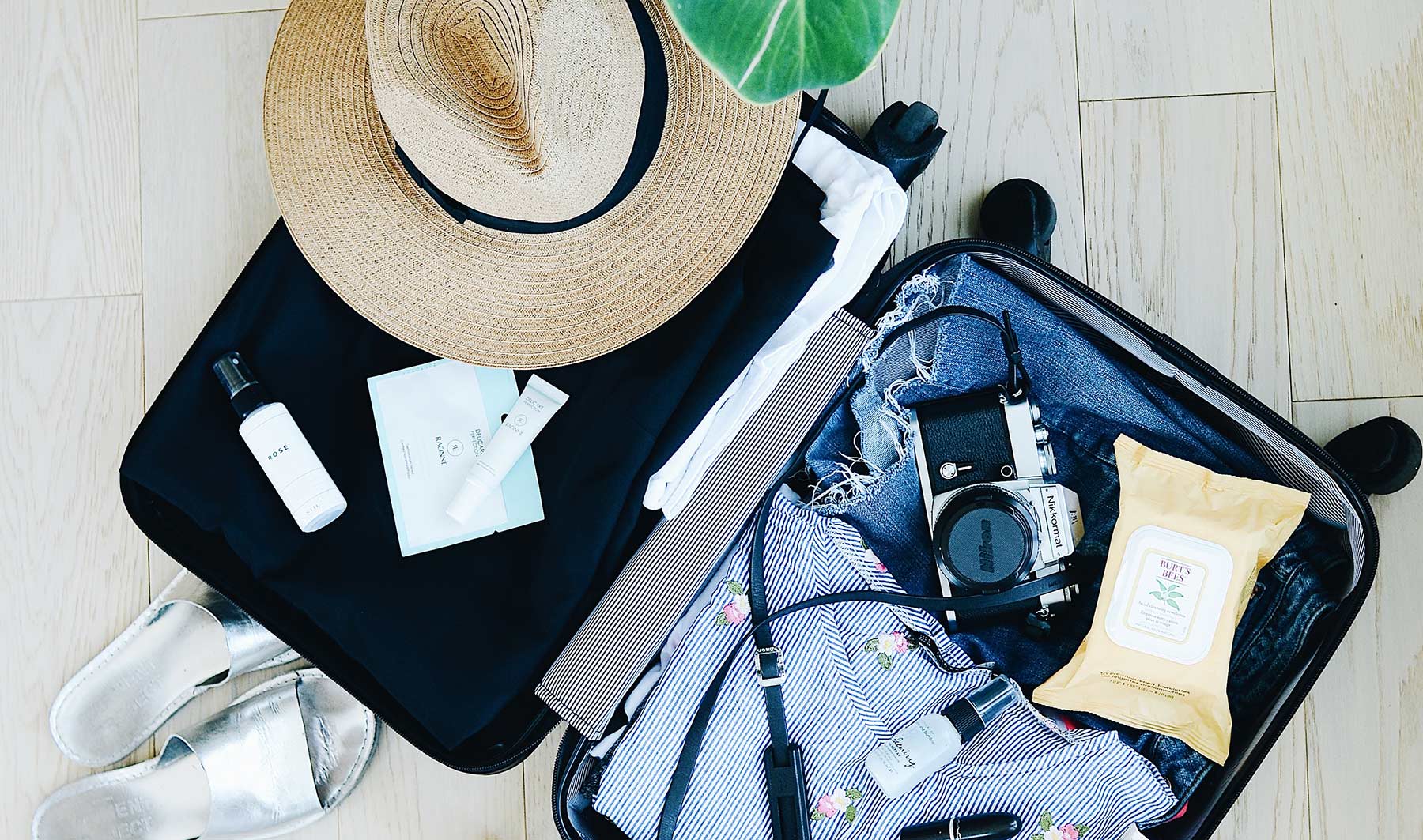After years of traveling the world, we’ve come to an important conclusion: traveling lighter is better.
When you travel light, you’re so much more mobile. Whether you’re backpacking across Europe or rushing through the streets of Tokyo, bringing less stuff with you opens up more room for experiences.
And by far the best way to travel light is to pack only a carry-on. To many travelers, this will seem impossible; how can you possibly fit everything you need in a small rolling bag or backpack?
As you’ll see in this guide, however, it’s a lot easier than you might think.
And once you switch to carry-on only packing, you’ll wonder why you ever needed a big, bulky suitcase.
So come along as we explore the fine art of packing a carry-on, including common mistakes to avoid.
4 Reasons to Travel with Only a Carry-On
Packing everything you need for a trip into a carry-on bag seems crazy at first. Why bother when the airline will let you check a big suitcase with plenty of room for all your stuff?
In our experience, there are four great reasons to only bring a carry-on:
1. To Save Money
Airlines are happy to let you bring as much luggage as you want…for a price. And if you’re trying to get your flight as cheaply as possible, baggage fees can really eat into your budget.
Unless you’re traveling on a super-budget airline like EasyJet or Frontier, you won’t have to pay extra for your carry-on bag. So skip the baggage fees and save that $25 for a tasty meal or fun souvenir.
2. Less to Keep Track Of
The more luggage you have, the more you have to worry about it forgetting it (or even worse, having it stolen). Plus, dragging a big suitcase everywhere really sucks, especially if you’re in a place with cobblestone or dirt streets.
Save yourself the hassle and leave that big bag at home; your travel will be less stressful and less exhausting.
3. No Lost Luggage
If you’ve spent much time in airports, you’ve probably seen the line of frantic people standing at the airline’s customer service desk attempting to find out where their lost luggage went. Or maybe you’ve even been one of those people.
Any time you check a bag, you run the risk of the airline losing it. This can really put a damper on your travels, especially if you’re far away from home, jetlagged, and already stressed. When you only pack a carry-on, you don’t have to worry about this unpleasant situation.
4. To Save Time
Even if the airline doesn’t lose your luggage, it’s normal to spend a half-hour or so waiting for it at the airport baggage claim.
In our opinion, this is a huge waste of time better spent exploring your destination (or collapsing into your warm bed if you’ve just returned from a trip). When you only have a carry-on, you can step off the plane and immediately exit the airport, no waiting required.
8 Tips to Pack the Perfect Carry-On
Convinced to make the switch to only a carry-on bag? Then let’s look at some tips for making your first carry-on only trip a success.
1. Follow the Liquids Rule
One common concern when packing a carry-on is: “What about my shampoo, conditioner, hand sanitizer, and other liquid toiletries?”
You can totally bring these items in your carry-on as long as you follow the rules. So what are the rules?
The TSA allows you to bring liquids, gels, and aerosols in containers of 3.4 oz (100 ml) or less. And all of these containers must fit in one quart-size (1 L) bag. Most other countries have similar rules in place (though be sure to check before traveling).
Most travel-size toiletries will comply with the 3.4 oz or less rule. And if you can’t find your favorite toiletries in a travel size, pick up some travel bottles and put your shampoo, conditioner, etc. in them.
Finally, be aware that the liquids rule also applies to “liquid-like foods,” including apple sauce, peanut butter, and yogurt. So if you plan to bring any of those with you in your carry-on bag, make sure they comply with the size requirements.
2. Don’t Bring Prohibited Items
While you can bring most liquids as long as they follow the size rules, there are some items that you’re never allowed to bring in a carry-on. Most of these items are common sense, including weapons, explosives, and things that could be used as a weapon.
Unfortunately, this includes useful items like Swiss Army knives and multi-tools, as well as hammers and screwdrivers. However, you can buy special multi-tools (more like keychains, really) that are allowed on the plane.
For a full list of what you can and can’t bring in both carry-on and checked baggage, consult this list from the TSA.
Finally, bear in mind that no matter what the website says, it’s ultimately up to airport security officers to decide what is and isn’t allowed through security. So if you’re in doubt about an item, it’s best to leave it at home.
3. Know the Airline’s Size and Weight Requirements
Airlines are pretty lenient about what they consider “carry-on baggage,” but most still have a size and weight requirement. I’ve never personally had an issue with this, but it’s something to be aware of if you’re on a budget airline.
The airline’s website will clearly tell you the maximum size and weight for carry-on and personal items. Normally, you should be more concerned about size (I’ve never seen an airline weigh a piece of carry-on luggage). But if you are worried about your bag’s weight, weight it with one of these portable luggage scales.
The best way to make sure your carry-on will fit is to buy a backpack or bag that’s made to be carried on a plane. If you’re a backpack person (like Trav), then we recommend the Tortuga Outbreaker. If you prefer a rolling bag (like Heather), then you’ll love the Bigger Carry On from Away.
4. Watch Out for Baggage Fees on Budget Airlines
A carry-on item is free on most airlines, but some budget carriers will charge a fee. They’ll usually make this policy very clear when you book your flight, but you should still check the airline’s website to make sure.
If you do have to pay for your carry-on, always do it before you get to the airport. If you wait until you get there, you’ll almost always pay more than if you had paid online. Paying for a carry-on is bad enough; don’t make it more expensive than it has to be.
5. Packing Cubes Are Your Friend
When we first heard about packing cubes, we were skeptical. Are they really worth the investment and extra time packing them?
After using them for a few years, we can report that the answer is an enthusiastic “Yes!” Packing cubes make it so much easier to fit all of your clothes into a small bag.
Additionally, we recommend rolling your clothes instead of folding them. Folding is nice for a department store display, but rolling is far more efficient when packing light. Rolled clothes + packing cubes = maximum space in your bag.
If you’re looking for packing cubes, we recommend this set from Tortuga. They’re designed to fit in the Outbreaker backpack, but they’ll work great in any bag.
6. Less Is More
When you pack a carry-on, you’ll need to leave certain items at home. The main adjustment for most people is the amount of clothing you can pack. If you’re used to packing 7 separate outfits for a seven-day trip, you’ll need to change your approach.
Instead of packing separate outfits, pack pieces that can make several different outfits. For a great illustration of this, check out our women’s packing guide podcast.
Also, remember that you can re-wear items. As long as something isn’t filthy or smelly, no one will care (or notice) if you repurpose it into a different outfit the next day. This is why we love Bluffworks clothing so much — their items resist stains and odors, letting you wear them for days at a time.
Finally, you can always do laundry if you need to. This could be at a local laundromat, wash and fold, or even in your hotel sink.
7. Don’t Pack What You Can Wear
When packing a carry-on, you want to minimize the number of heavy items. Otherwise, you’ll put unnecessary strain on your back or arms when carrying the bag around.
A common mistake we see is to pack boots or other heavy shoes. While they might not be the comfiest to wear on the plane, you’re better off wearing them and packing your sandals or lightweight sneakers. You can always take the boots off once the plane is in the air.
The same goes for scarves, gloves, and other accessories. Don’t put them in your bag; stash them in your pockets or on your person. Ditto for any jackets that you’re bringing. You can always take your jacket off once the flight is in the air (though it might be nice to have given the arctic temperatures aboard most planes).
8. Don’t Pack What You Can Keep on Your Phone
Gone are the days when the only way to carry plane tickets, itineraries, maps, and travel guides was on paper in your bag. These days, you can keep most of that information on your phone or computer.
Sure, paper copies can be helpful in some cases, but unless you need to have a paper copy of a ticket (as some airlines and trains do require), save yourself the bulk and have digital copies. Just be sure to bring a charger!
What to Pack in Your Carry-On
We hope you now understand how to pack a carry-on for maximum efficiency and ease of travel. But what should you bring with you?
Ultimately, that’s a personal decision; everyone’s needs will be different. But for some ideas, we recommend you check out these guides:
- The Best Gifts for Travelers – A guide to our favorite travel gifts, most of which are carry-on-friendly.
- Our Ultimate Packing List – This podcast episode goes over our essential items for every trip, whether you’re traveling solo or with kids.
- Pre-Travel Checklist: 24 Things to Do Before You Travel – You’ll find many essential carry-on items on this list.
Safe travels!
Backpack image courtesy of Tortuga.



